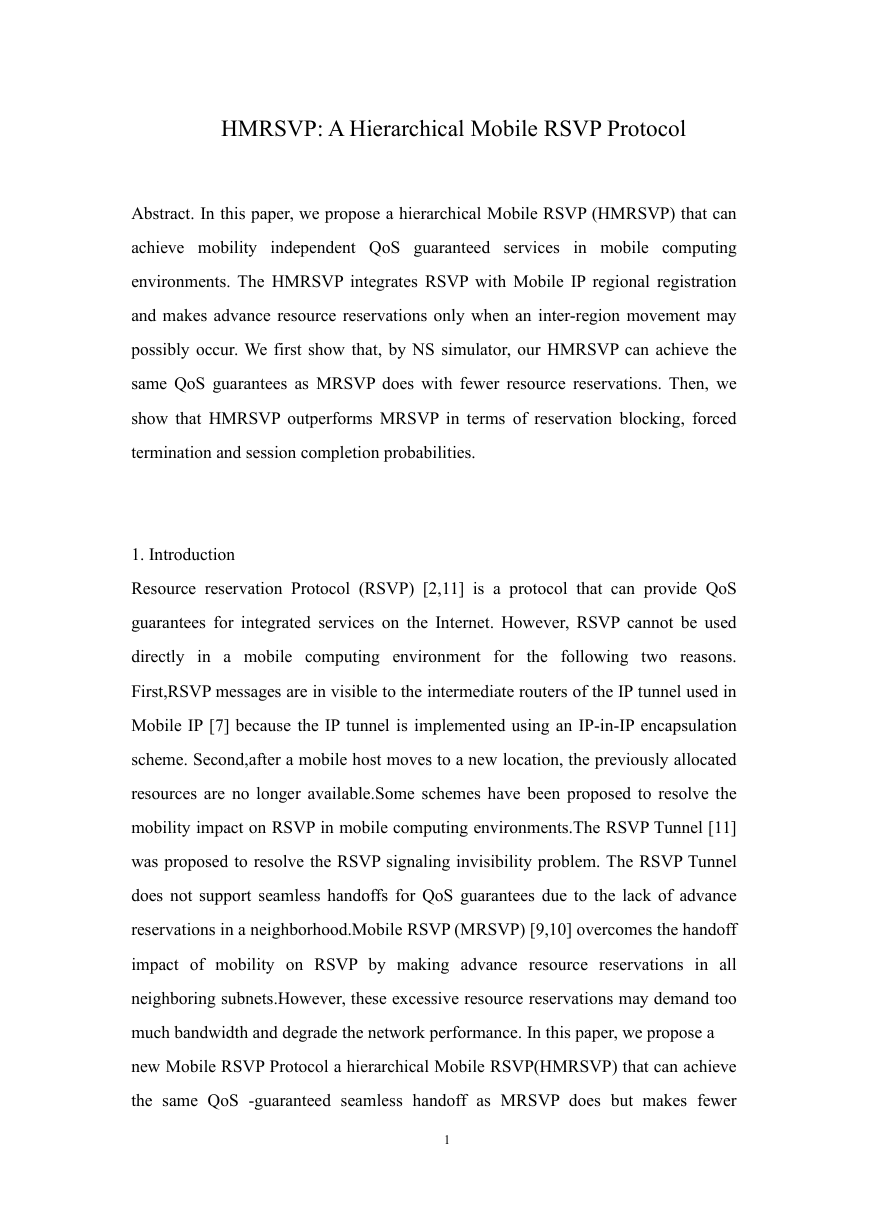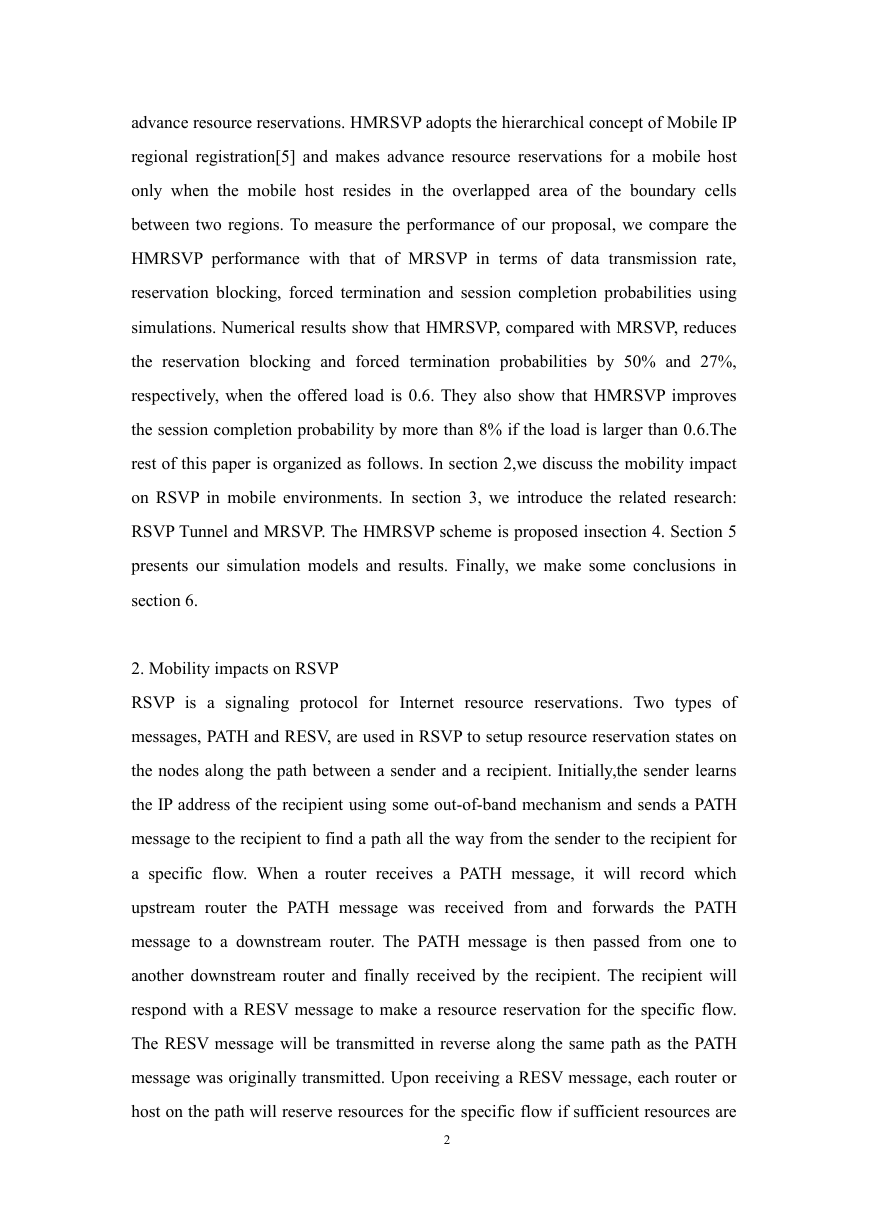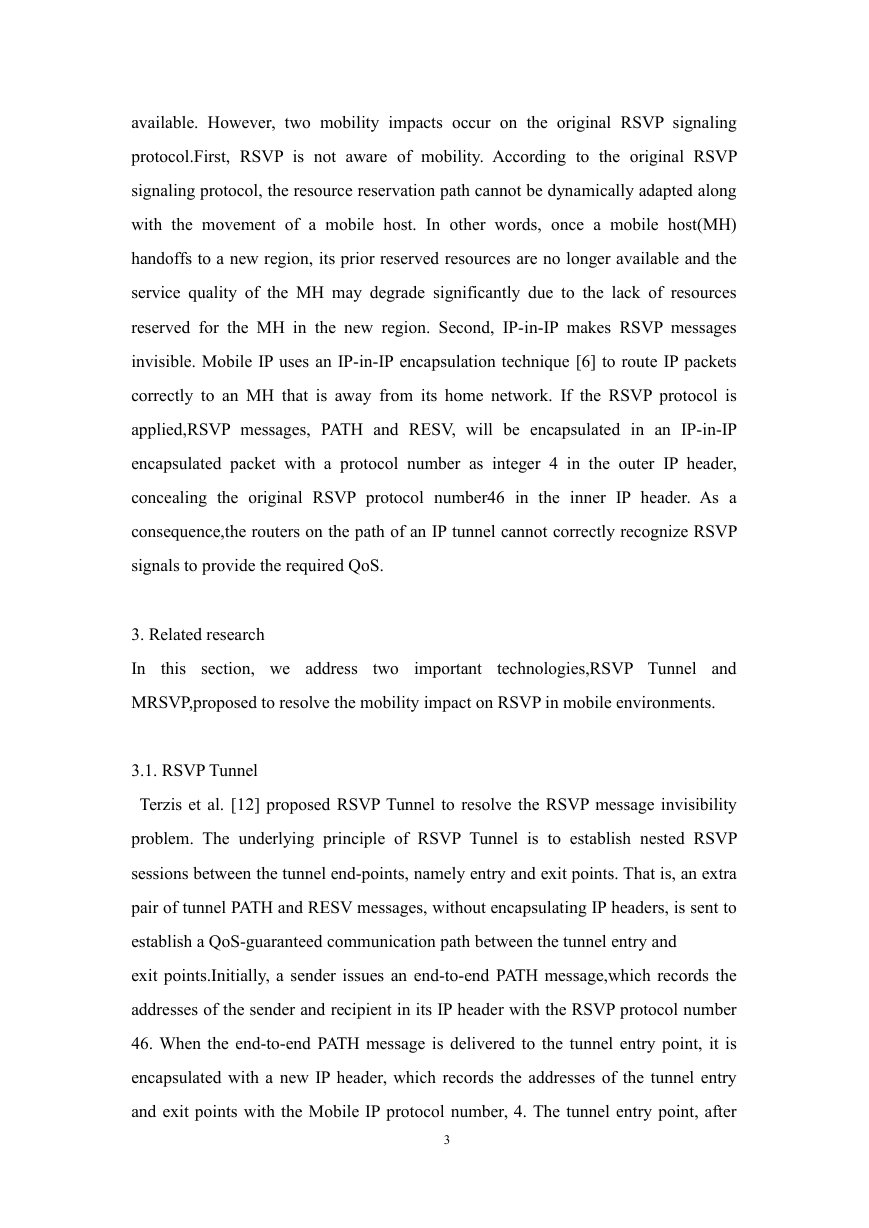HMRSVP: A Hierarchical Mobile RSVP Protocol
Abstract. In this paper, we propose a hierarchical Mobile RSVP (HMRSVP) that can
achieve mobility independent QoS guaranteed services in mobile computing
environments. The HMRSVP integrates RSVP with Mobile IP regional registration
and makes advance resource reservations only when an inter-region movement may
possibly occur. We first show that, by NS simulator, our HMRSVP can achieve the
same QoS guarantees as MRSVP does with fewer resource reservations. Then, we
show that HMRSVP outperforms MRSVP in terms of reservation blocking, forced
termination and session completion probabilities.
for
1. Introduction
Resource reservation Protocol (RSVP) [2,11] is a protocol that can provide QoS
guarantees for integrated services on the Internet. However, RSVP cannot be used
directly in a mobile computing environment
the following two reasons.
First,RSVP messages are in visible to the intermediate routers of the IP tunnel used in
Mobile IP [7] because the IP tunnel is implemented using an IP-in-IP encapsulation
scheme. Second,after a mobile host moves to a new location, the previously allocated
resources are no longer available.Some schemes have been proposed to resolve the
mobility impact on RSVP in mobile computing environments.The RSVP Tunnel [11]
was proposed to resolve the RSVP signaling invisibility problem. The RSVP Tunnel
does not support seamless handoffs for QoS guarantees due to the lack of advance
reservations in a neighborhood.Mobile RSVP (MRSVP) [9,10] overcomes the handoff
impact of mobility on RSVP by making advance resource reservations in all
neighboring subnets.However, these excessive resource reservations may demand too
much bandwidth and degrade the network performance. In this paper, we propose a
new Mobile RSVP Protocol a hierarchical Mobile RSVP(HMRSVP) that can achieve
the same QoS -guaranteed seamless handoff as MRSVP does but makes fewer
1
�
advance resource reservations. HMRSVP adopts the hierarchical concept of Mobile IP
regional registration[5] and makes advance resource reservations for a mobile host
only when the mobile host resides in the overlapped area of the boundary cells
between two regions. To measure the performance of our proposal, we compare the
HMRSVP performance with that of MRSVP in terms of data transmission rate,
reservation blocking, forced termination and session completion probabilities using
simulations. Numerical results show that HMRSVP, compared with MRSVP, reduces
the reservation blocking and forced termination probabilities by 50% and 27%,
respectively, when the offered load is 0.6. They also show that HMRSVP improves
the session completion probability by more than 8% if the load is larger than 0.6.The
rest of this paper is organized as follows. In section 2,we discuss the mobility impact
on RSVP in mobile environments. In section 3, we introduce the related research:
RSVP Tunnel and MRSVP. The HMRSVP scheme is proposed insection 4. Section 5
presents our simulation models and results. Finally, we make some conclusions in
section 6.
2. Mobility impacts on RSVP
RSVP is a signaling protocol for Internet resource reservations. Two types of
messages, PATH and RESV, are used in RSVP to setup resource reservation states on
the nodes along the path between a sender and a recipient. Initially,the sender learns
the IP address of the recipient using some out-of-band mechanism and sends a PATH
message to the recipient to find a path all the way from the sender to the recipient for
a specific flow. When a router receives a PATH message, it will record which
upstream router the PATH message was received from and forwards the PATH
message to a downstream router. The PATH message is then passed from one to
another downstream router and finally received by the recipient. The recipient will
respond with a RESV message to make a resource reservation for the specific flow.
The RESV message will be transmitted in reverse along the same path as the PATH
message was originally transmitted. Upon receiving a RESV message, each router or
host on the path will reserve resources for the specific flow if sufficient resources are
2
�
available. However, two mobility impacts occur on the original RSVP signaling
protocol.First, RSVP is not aware of mobility. According to the original RSVP
signaling protocol, the resource reservation path cannot be dynamically adapted along
with the movement of a mobile host. In other words, once a mobile host(MH)
handoffs to a new region, its prior reserved resources are no longer available and the
service quality of the MH may degrade significantly due to the lack of resources
reserved for the MH in the new region. Second, IP-in-IP makes RSVP messages
invisible. Mobile IP uses an IP-in-IP encapsulation technique [6] to route IP packets
correctly to an MH that is away from its home network. If the RSVP protocol is
applied,RSVP messages, PATH and RESV, will be encapsulated in an IP-in-IP
encapsulated packet with a protocol number as integer 4 in the outer IP header,
concealing the original RSVP protocol number46 in the inner IP header. As a
consequence,the routers on the path of an IP tunnel cannot correctly recognize RSVP
signals to provide the required QoS.
3. Related research
In this
MRSVP,proposed to resolve the mobility impact on RSVP in mobile environments.
technologies,RSVP Tunnel and
section, we address
two important
3.1. RSVP Tunnel
Terzis et al. [12] proposed RSVP Tunnel to resolve the RSVP message invisibility
problem. The underlying principle of RSVP Tunnel is to establish nested RSVP
sessions between the tunnel end-points, namely entry and exit points. That is, an extra
pair of tunnel PATH and RESV messages, without encapsulating IP headers, is sent to
establish a QoS-guaranteed communication path between the tunnel entry and
exit points.Initially, a sender issues an end-to-end PATH message,which records the
addresses of the sender and recipient in its IP header with the RSVP protocol number
46. When the end-to-end PATH message is delivered to the tunnel entry point, it is
encapsulated with a new IP header, which records the addresses of the tunnel entry
and exit points with the Mobile IP protocol number, 4. The tunnel entry point, after
3
�
sending the encapsulated end-to-end PATH message, issues a new tunnel PATH
message which records the addresses of the tunnel entry and exit points with the
RSVP protocol number 46. On receiving the encapsulated end-to-end PATH message,
each router on the path of the tunnel directly forwards the message downstream to the
exit point. However, on receiving the tunnel PATH message, each router performs the
pathfinding function as described in the original RSVP protocol because the RSVP
protocol number 46 is visible in this message. When these tunnel and encapsulated
end-to-end PATH messages arrive at the exit point, the encapsulated end-to-end.PATH
message will be decapsulated and forwarded to the recipient, while the tunnel PATH
message will be processed only by the exit point and need not be forwarded to the
recipient. In response, the recipient, on receiving the end-to-end.PATH message,
replies an end-to-end RESV message to the sender. In a similar way, when the tunnel
exit point receives the end-to-end RESV message, it will tunnel the message to the
sender as described before. In addition, the tunnel exit point will also issue a tunnel
RESV message to the tunnel entry point. Thus, all routers on the tunnel path, when
receiving the tunnel RESV message, can reserve the desired resources for the
recipient if sufficient resources are available.Using the above nested RSVP session,
RSVP Tunnel can actually resolve the RSVP signaling invisibility problem.However,
it does not make advance resource reservations in its neighboring networks. Therefore,
if an MH moves to a new foreign region, the MH’s service may be terminated be-
cause of the lack of resources in the new region.
4
�








 2023年江西萍乡中考道德与法治真题及答案.doc
2023年江西萍乡中考道德与法治真题及答案.doc 2012年重庆南川中考生物真题及答案.doc
2012年重庆南川中考生物真题及答案.doc 2013年江西师范大学地理学综合及文艺理论基础考研真题.doc
2013年江西师范大学地理学综合及文艺理论基础考研真题.doc 2020年四川甘孜小升初语文真题及答案I卷.doc
2020年四川甘孜小升初语文真题及答案I卷.doc 2020年注册岩土工程师专业基础考试真题及答案.doc
2020年注册岩土工程师专业基础考试真题及答案.doc 2023-2024学年福建省厦门市九年级上学期数学月考试题及答案.doc
2023-2024学年福建省厦门市九年级上学期数学月考试题及答案.doc 2021-2022学年辽宁省沈阳市大东区九年级上学期语文期末试题及答案.doc
2021-2022学年辽宁省沈阳市大东区九年级上学期语文期末试题及答案.doc 2022-2023学年北京东城区初三第一学期物理期末试卷及答案.doc
2022-2023学年北京东城区初三第一学期物理期末试卷及答案.doc 2018上半年江西教师资格初中地理学科知识与教学能力真题及答案.doc
2018上半年江西教师资格初中地理学科知识与教学能力真题及答案.doc 2012年河北国家公务员申论考试真题及答案-省级.doc
2012年河北国家公务员申论考试真题及答案-省级.doc 2020-2021学年江苏省扬州市江都区邵樊片九年级上学期数学第一次质量检测试题及答案.doc
2020-2021学年江苏省扬州市江都区邵樊片九年级上学期数学第一次质量检测试题及答案.doc 2022下半年黑龙江教师资格证中学综合素质真题及答案.doc
2022下半年黑龙江教师资格证中学综合素质真题及答案.doc